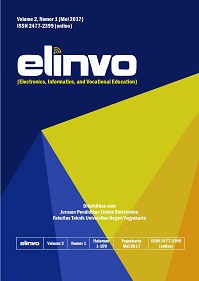Crowd Detection System Using Blimp Drones as an Effort to Mitigate the Spread of Covid-19 Based on Internet of Things
DOI:
https://doi.org/10.21831/elinvo.v6i2.43873Keywords:
Covid-19, Blimp Drone, Detection, Internet of ThingsAbstract
References
R. Widiyani, "Tentang New Normal di Indonesia: Arti, Fakta dan Kesiapan Daerah," https://news.detik.com/berita/d-5034719/tentang-new-normal-di-indonesia-arti-fakta-dan-kesiapan-daerah, 2020. .
K. U. Kulsum, "Wisata Aman: Kebijakan Sektor Pariwisata di Tengah Pandemi Covid-19," https://kompaspedia.kompas.id/baca/paparan-topik/wisata-aman-kebijakan-sektor-pariwisata-di-tengah-pandemi-covid-19, 2021. .
V. Mai et al., "Local Positioning System Using UWB Range Measurements for an Unmanned Blimp," IEEE Robot. Autom. Lett., vol. 3, no. 4, pp. 2971–2978, 2018, doi: 10.1109/LRA.2018.2849553.
H. Chen, X. M. Wang, and Y. Li, "A survey of autonomous control for UAV," 2009 Int. Conf. Artif. Intell. Comput. Intell. AICI 2009, vol. 2, pp. 267–271, 2009, doi: 10.1109/AICI.2009.147.
A. G. Florea and C. Buiu, "Sensor fusion for autonomous drone waypoint navigation using ros and numerical p systems: A critical analysis of its advantages and limitations," Proc. - 2019 22nd Int. Conf. Control Syst. Comput. Sci. CSCS 2019, pp. 112–117, 2019, doi: 10.1109/CSCS.2019.00027.
M. Aljehani and M. Inoue, "Multi-UAV tracking and scanning systems in M2M communication for disaster response," 2016 IEEE 5th Glob. Conf. Consum. Electron. GCCE 2016, pp. 2–3, 2016, doi: 10.1109/GCCE.2016.7800524.
A. R. Al Tahtawi, E. Andika, M. Yusuf, and W. N. Harjanto, "Design of Quadrotor UAV and Internet-of-Things Based Air Pollution Monitoring Systems," IJITEE (International J. Inf. Technol. Electr. Eng., vol. 3, no. 4, p. 120, 2020, doi: 10.22146/ijitee.51203.
K. K. Patel, S. M. Patel, and P. G. Scholar, "Internet of Things-IOT: Definition, Characteristics, Architecture, Enabling Technologies, Application & Future Challenges," Int. J. Eng. Sci. Comput., vol. 6, no. 5, pp. 1–10, 2016, doi: 10.4010/2016.1482.
F. Arifin, R. A. Daniel, and D. Widiyanto, "Autonomous Detection and Tracking of an Object Autonomously Using Ar.Drone Quadcopter," J. Ilmu Komput. dan Inf., vol. 7, no. 1, pp. 11–17, 2014, doi: 10.21609/jiki.v7i1.251.
Y. C. Hou, M. Z. Baharuddin, S. Yussof, and S. Dzulkifly, "Social Distancing Detection with Deep Learning Model," 2020 8th Int. Conf. Inf. Technol. Multimedia, ICIMU 2020, pp. 334–338, 2020, doi: 10.1109/ICIMU49871.2020.9243478.
N. Xuan-Mung and S. K. Hong, "Improved altitude control algorithm for quadcopter unmanned aerial vehicles," Appl. Sci., vol. 9, no. 10, 2019, doi: 10.3390/app9102122.
M. M. Lambacing and F. Ferdiansyah, "Rancang Bangun New Normal Covid-19 Masker Detektor Dengan Notifikasi Telegram Berbasis Internet of Things," Dinamik, vol. 25, no. 2, pp. 77–84, 2020, doi: 10.35315/dinamik.v25i2.8070.
N. Bagal and P. S. Pandita, "Transmission of Audio Over Wireless Networks Using Raspberry Pi in Real-Time," Int. J. Innov. Res. Sci. Eng. Technol., vol. 4, no. 9, pp. 9435–9440, 2015, doi: 10.15680/IJIRSET.2015.0409157.
I. N. B. Hartawan and I. W. Sudiarsa, "Analisis Kinerja Internet of Things Berbasis Firebase Real-Time Database," J. Resist. (Rekayasa Sist. Komputer), vol. 2, no. 1, pp. 6–17, 2019, doi: 10.31598/jurnalresistor.v2i1.371.
R. Bayareh, A. Vera, L. Leija, and J. Gutierrez-Martínez, "Development of a thermographic image instrument using the raspberry Pi embedded system for the study of the diabetic foot," I2MTC 2018 - 2018 IEEE Int. Instrum. Meas. Technol. Conf. Discov. New Horizons Instrum. Meas. Proc., pp. 1–6, 2018, doi: 10.1109/I2MTC.2018.8409841.
M. Tayyab, U. Farooq, Z. Ali, M. Imran, and F. Shahzad, "Design of a blimp based unmanned aerial vehicle for surveillance," Int. J. Eng. Technol., vol. 5, no. 1, pp. 519–530, 2013.
R. Liu and Z. Ren, "Application of Yolo on Mask Detection Task," 2021 IEEE 13th Int. Conf. Comput. Res. Dev. ICCRD 2021, pp. 130–136, 2021, doi: 10.1109/ICCRD51685.2021.9386366.
M. Abadi et al., "TensorFlow: A system for large-scale machine learning," USENIX, vol. 33, no. 1, pp. 582–598, 2016, doi: 10.1016/0076-6879(83)01039-3.
F. L. Ahmad, A. Nugroho, and F. Suni, "Deteksi Pemakai Masker Menggunakan Metode Haar Cascade Sebagai Pencegahaan COVID 19," vol. 10, no. 1, pp. 13–18, 2021.
B. M. Susanto, E. S. J. Atmadji, and W. L. Brenkman, "Implementasi Mqtt Protocol Pada Smart Home Security Berbasis Web," J. Inform. Polinema, vol. 4, no. 3, p. 201, 2018, doi: 10.33795/jip.v4i3.207.
Downloads
Published
How to Cite
Issue
Section
Citation Check
License
The article published in ELINVO became ELINVO's right in publication.
This work by ELINVO is licensed under a Creative Commons Attribution-NonCommercial 4.0 International License.









